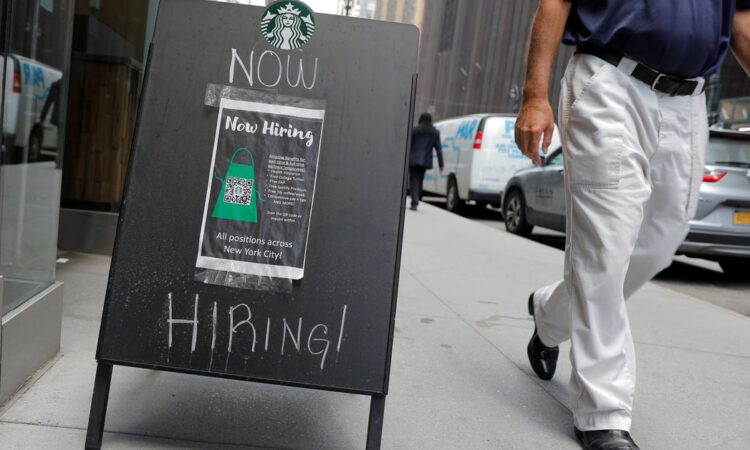
WASHINGTON, Oct 5 (Reuters) – The number of Americans filing new claims for unemployment benefits rose moderately last week, while layoffs declined in September, pointing to still-tight labor market conditions at the end of the third quarter.
The economy’s prospects during the last quarter were bolstered by other data on Thursday showing the trade deficit shrinking to its smallest in nearly three years in August, with exports of capital goods hitting a record high. The economy has so far weathered hefty interest rate increases from the Federal Reserve to cool demand. That resilience raises the risk of the U.S. central bank hiking rates again by year end.
“Demand in the economy continues to strengthen which can only serve to worry Fed officials even more, and puts the progress in bringing inflation down in jeopardy,” said Christopher Rupkey, chief economist at FWDBONDS in New York.
Initial claims for state unemployment benefits increased 2,000 to a seasonally adjusted 207,000 for the week ended Sept. 30, the Labor Department said. Economists polled by Reuters had forecast 210,000 claims for the latest week.
For much of September, claims hovered in the lower end of their 194,000-265,000 band for this year.
Employers are generally reluctant to let go of their workers following difficulties finding labor in the aftermath of the COVID-19 pandemic. An Institute for Supply Management survey on Wednesday found that services businesses still viewed the labor market as “very competitive,” with some employers reporting difficulties backfilling positions.
Unadjusted claims fell 2,875 to 172,775 last week. Claims in Ohio dropped 1,629, which together with moderate decreases elsewhere more than offset a 1,650 increase in California.
Claims could push higher this month as the United Auto Workers (UAW) strike, now in its third week, constrains supply chains and forces manufacturers to temporarily lay off more non-striking workers. Ford Motor (F.N), General Motors (GM.N) and Chrysler-parent Stellantis (STLAM.MI) have furloughed and laid off hundreds of workers because of strike impacts.
Though conditions remain tight, the labor market is gradually cooling. The government reported on Tuesday that there were 1.51 job openings for every unemployed person in August and unfilled positions increased by the most in two years.
Stocks on Wall Street were trading lower. The dollar dipped against a basket of currencies. U.S. Treasury prices were mixed.
LAYOFFS DECLINE
A separate report from global outplacement firm Challenger, Gray & Christmas on Thursday showed U.S. companies announced 47,457 job cuts in September, down 37% from August. Announced layoffs were, however, 58% higher compared to the same period last year. Employers announced 146,305 job cuts in the third quarter, down 22% from the April-June quarter.
Labor market strength suggests the Fed could keep interest rates higher for some time. Most economists believe the central bank is done hiking rates. Since March 2022, it has raised its benchmark overnight interest rate by 525 basis points to the current 5.25%-5.50% range.
The number of people receiving jobless benefits after an initial week of aid, a proxy for hiring, slipped 1,000 to 1.664 million during the week ending Sept. 23, the claims report showed. The claims data have no bearing on September’s employment report, due for release on Friday, as they fall outside the survey period.
But claims dropped below 220,000 in September which some economists said suggested job growth could beat expectations.
According to a Reuters survey of economists, nonfarm payrolls likely increased by 170,000 jobs last month after rising 187,000 in August. The unemployment rate is forecast dipping to 3.7% from 3.8% in August.
“We look for payrolls to remain firm in September, registering a 210,000 gain,” said Oscar Munoz, chief U.S. macro strategist at TD Securities in New York.
A third report from the Commerce Department showed the trade deficit contracted 9.9% to $58.3 billion, the lowest level since September 2020. Economists had forecast the trade gap narrowing to $62.3 billion. The inflation-adjusted goods deficit decreased 5.1% to $83.9 billion.
Exports of goods and services increased 1.6% to $256.0 billion. Goods exports shot up 1.8% to $171.5 billion, with shipments of capital goods hitting a record high. But exports of foods, feeds and beverages were the lowest since August 2020.
Exports of services rose $1.0 billion to $84.5 billion, the highest on record, mostly reflecting increases in travel and financial services.
Imports of goods and services fell 0.7% to $314.3 billion. Goods imports dropped 0.9% to $256.0 billion amid declines in imports of consumer and capital goods, potentially flagging softening domestic demand amid higher borrowing costs.
Cell phones and other household goods accounted for the drop in consumer goods imports. The decrease in capital goods imports reflected declines in semiconductors and electric apparatus.
Services imports increased $0.1 billion to $58.4 billion, supported by travel and other business services. Imports of transportation services fell. The services surplus increased $1.0 billion to $26.2 billion, the highest since March 2018.
Economists expect trade would add at least a full percentage point to gross domestic product growth in the third quarter after being neutral in the April-June quarter.
Goldman Sachs boosted its third-quarter GDP growth estimate by 0.3 percentage point to a 3.7% annualized rate. The economy grew at a 2.1% pace in the second quarter.
“The tightening of the trade balance should boost GDP as foreign consumers buy more American goods and as the manufacturing industry comes off its bottom,” said Veronica Clark, an economist at Citigroup in New York. “Growth is likely to remain supported in the near term.”
Reporting by Lucia Mutikani; Editing by Chizu Nomiyama and Andrea Ricci
Our Standards: The Thomson Reuters Trust Principles.






